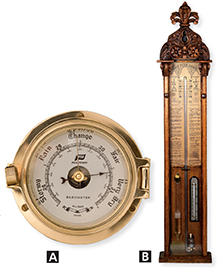Layers of the Atmosphere
Temperature changes dramatically as you move up from Earth's surface high into the atmosphere. Scientists use variations in temperature to divide the atmosphere into four vertical layers.  The four layers of the atmosphere are the troposphere, the stratosphere, the mesosphere, and the thermosphere.
The four layers of the atmosphere are the troposphere, the stratosphere, the mesosphere, and the thermosphere.
The Troposphere
You, along with many other living things, live in the layer of the atmosphere called the troposphere. The troposphere (TROH puh sfeer) is the lowest layer of Earth's atmosphere. This layer contains almost all of the atmosphere's water vapor and suspended particles, which are important in the formation of clouds and precipitation. Most weather takes place in the troposphere. Weather is the condition of the atmosphere in a particular place at a particular time.
The height of the troposphere ranges from about 9 kilometers above the poles to 16 kilometers above the tropics. The average height of the troposphere is about 12 kilometers.
In the troposphere, temperature generally decreases as altitude increases. Though it varies somewhat, the rate of decrease averages about 6.5 Celsius degrees per kilometer. For example, if it is 20°C where you are on Earth's surface, then it is probably about 7°C at an altitude of 2 kilometers above you. This characteristic of the troposphere accounts for the extremely low temperatures that Hillary and Tenzing had to withstand when they scaled Mount Everest.
Figure 4 Barometers measure air pressure. A Changes in air pressure cause the airtight chamber of this aneroid barometer to flex in and out. B Changes in air pressure cause the level of mercury in the open glass tube of this antique mercury barometer to move up or down.

Quick Lab
Demonstrating the Effect of Air Pressure
Materials
plastic cup, index card, plastic tub
Procedure 
Completely fill the plastic cup with water. Then place the index card on the cup. Make sure that no air is trapped between the water and the card. CAUTION Quickly wipe up any spilled water to avoid slips and falls.
Predicting Record your prediction of what will happen when the cup is inverted.
To test your prediction, place the palm of one hand on the card. Then use your other hand to invert the cup so that the cup rests upside-down on the card in your hand.
Hold the cup and card over the plastic tub and slowly remove your hand from the card. Observe what happens.
Analyze and Conclude
Applying Concepts What two forces acted on the card after you inverted the cup?
Inferring After you inverted the cup, which surface of the card experienced a greater force due to air pressure?
Drawing Conclusions How can you explain what happened when you removed your hand from the card?




